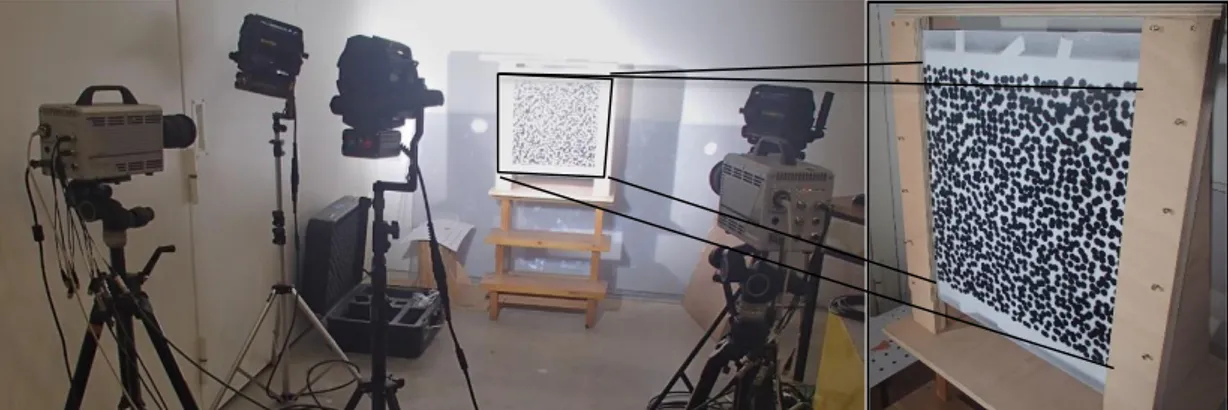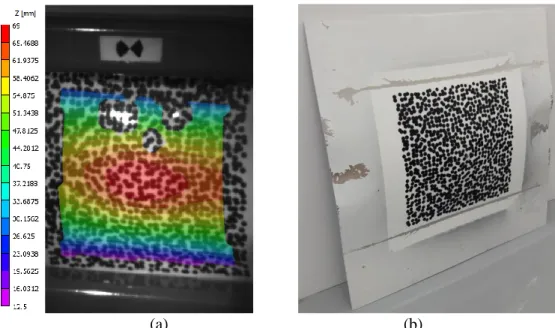HAL Id: hal-01545182
https://hal.archives-ouvertes.fr/hal-01545182
Submitted on 22 Jun 2017
HAL is a multi-disciplinary open access
archive for the deposit and dissemination of
sci-entific research documents, whether they are
pub-lished or not. The documents may come from
teaching and research institutions in France or
abroad, or from public or private research centers.
L’archive ouverte pluridisciplinaire HAL, est
destinée au dépôt et à la diffusion de documents
scientifiques de niveau recherche, publiés ou non,
émanant des établissements d’enseignement et de
recherche français ou étrangers, des laboratoires
publics ou privés.
3D Digital Image Correlation Applied to Birdstrike
Tests
Ludovic Barrière, Olivier Cherrier, Jean-Charles Passieux, Michel Bouquet,
Jean-François Ferrero
To cite this version:
Ludovic Barrière, Olivier Cherrier, Jean-Charles Passieux, Michel Bouquet, Jean-François Ferrero. 3D
Digital Image Correlation Applied to Birdstrike Tests. First Annual Conference of the International
Digital Imaging Correlation Society (iDICS 2016), Nov 2016, Philadelphie, PA, United States.
pp.17-20, �10.1007/978-3-319-51439-0_4�. �hal-01545182�
3D DIGITAL IMAGE CORRELATION APPLIED TO
BIRDSTRIKE TESTS
L. Barrière
1*, O. Cherrier
2, J.-C. Passieux
2, M. Bouquet
1, J.-F. Ferrero
2 1Institute of Research and Technology Saint Exupery, 118 Route de Narbonne
CS44248, 31432 Toulouse Cedex 4, France
2
Institut Clément Ader, UFTMP / UMR CNRS 5312, 3 rue Caroline Aigle, 31400
Toulouse, France
ABSTRACT
The development of new bird strike shielding materials for commercial aircrafts requires test campaigns. During these tests, measurement of the high speed deformation is needed to characterize and compare the mechanical response of the shielding samples and to correlate numerical simulations with experi-ments. In this work, 3D digital image correlation method is used with high speed (HSP) cameras to compute the displacement and strain fields on a large area (approximately 400mm wide) of the back side of impacted samples. Compromise on spatial resolution, frame rate of HSP camera and measurement error is discussed.
Keywords: 3D DIC, High speed camera, Bird strike, Wide ROI, High velocity impact
1. INTRODUCTION
Among the quantities of interest measurable during a bird strike test, one is the deformation of the target that could help correlate simulations with experiments and compare different targets one to each other. Deformations are often measured by strain gages [1] but particular attention has been paid recently to 3D digital image correlation (DIC) for HVI or blast [2]–[4] when region of interest (ROI) remains properly visible during test. The main challenge is to find a compromise between measurement accuracy and size of the ROI because of the lower resolution of high speed cameras.
In the framework of project FUI SAMBA led by Stelia Aerospace, which aims at developing new shield-ing concepts for protectshield-ing the cockpit of aircrafts against bird strike, the back side of shieldshield-ing samples remains visible during test. The ROI of such one square meter target may span several hundred millime-ters side length. In this paper, the ROI reaches 400mm by 400mm corresponding to the average length between stringers of the structure which was considered to be protected.
2. PRELIMINARY STUDY
Before bird strike tests, 3D DIC capabilities were evaluated. As shown in Figure 1, two high speed cameras (Photron APX) are used for stereo-vision. At a rate of 30000 frames per second, resolution was 256 by 256 pixels. A coarse high contrast random pattern (bullet points of diameter approximately equal to 10mm) has been painted on a mock target plate such that the transition between black and white area corresponds to approximately four pixels [5].
After calibration, correlation was successful in the ROI2. Figure 2 shows the mock target in reference
and rotated positions and its shape reconstruction by stereo-correlation. The maximum out-of-plane dis-placement that was measured is about 40mm (Figure 2.b). As target plate remains planar and not de-formed, computed strain should remain very small [6]. A normal strain of 6.10−4 is computed which seems satisfactory at this stage for the application (Figure 2.c).
*Corresponding author
E-mail address: ludovic.barriere@irt-saintexupery.com (L. Barrière)
Figure 1.Stereo-correlation device comprising high speed camera and large scale target with coarse speckle pattern.
(a)
(b)
(c)
Figure 2
.
3D surface reconstruction of the target in reference position (a) vertically rotated position (b) and computation of strain field in rotated position (𝜖𝑥𝑥< 6.10−4) (c)3. BIRDSTRIKE TEST AND APPLICATION OF 3D-DIC
The bird strike tests are performed at the High Velocity Impact Test Platform in Toulouse, France, which has been co-developed by IRT Saint Exupery and Institut Clément Ader (UMR CNRS 5312) for the last 2 years. A 120mm diameter gaz launcher is used to shoot 1,5kg substitute bird (homemade gelatin cyl-inder) at 170-180m/s. An aluminum plate (dimensions: 800mm x 800mm x 6mm) is simply supported by two parallel beams of a stiff chassis (see Figure 3.a). The camera setup is such that distance to target is approximately 2,5m and the angle between the axes of cameras is 30°. Cameras are placed outside the shooter enclosure whose backside wall is made of polycarbonate plates (see Figure 3.b).
(a) (b)
Figure 3: Stiff chassis supporting the target (a). High speed camera setup for 3D DIC (b).
The frame rate of cameras is set to 30000fps. The corresponding maximum resolution of 256 by 384 pixels is chosen so that a marker placed on the upper beam of the chassis is in the field of view (Marker tracking on the chassis enables the assessment of the boundary conditions).
Y
y
x
y
x
(a) (b)
Figure 4: (a) 3D DIC of the plate during bird strike, (b) state of the plate after impact
After calibration of the stereo system, 3D image correlation of the ROI is performed by VIC3D. As shown in figure above, correlation algorithm may not converge in some areas of some images due to light reflection on the deformed target. Nevertheless, the deformation of the plate can be evaluated in most of the ROI for all the images during the impact event. The maximum computed normal displace-ment reaches then 70mm.
4. CONCLUSIONS
The preliminary study has open interesting prospects for the use of 3D DIC for bird strike tests on shield-ing concepts. It was shown that large region of interest could be considered while keepshield-ing a quite good accuracy of measurement of displacement and strain fields. The second step of this work has imple-mented the stereo-correlation device in bird strike test conditions of the impact test platform which is co-developed by IRT Saint-Exupery and Institut Clément Ader. Further analyses are planned to assess and reduce the measurement error and to correlate with numerical simulations of bird strike.
ACKNOWLEDGEMENT
This work is done in the framework of projects COMPINNOV TD of IRT Saint Exupery and FUI SAMBA. The authors want to thank industrial and academic partners: Stelia Aerospace, Airbus Group, Hutchinson, Ateca, Nimitech, Esteve, Cedrem, Institut Clément Ader, I2M.
REFERENCES
[1] M. Guida, F. Marulo, M. Meo, and S. Russo, “Certification by birdstrike analysis on C27J fullscale ribless composite leading edge,” Int. J. Impact Eng., vol. 54, pp. 105–113, avril 2013.
[2] S. Gupta, V. Parameswaran, M. A. Sutton, and A. Shukla, “Study of dynamic underwater implosion mechanics using digital image correlation,” Proc. R. Soc. Math. Phys. Eng. Sci., vol. 470, no. 2172, pp. 20140576–20140576, Oct. 2014.
[3] V. Tiwari, M. A. Sutton, S. R. McNeill, S. Xu, X. Deng, W. L. Fourney, and D. Bretall, “Application of 3D image correlation for full-field transient plate deformation measurements during blast load-ing,” Int. J. Impact Eng., vol. 36, no. 6, pp. 862–874, juin 2009.
[4] B. L. Gérald Portemont, “An innovative experimental device for ice impact onto composite panel,” 2014.
[5] X. Ke, M. A. Sutton, S. M. Lessner, and M. Yost, “Robust stereo vision and calibration methodol-ogy for accurate three-dimensional digital image correlation measurements on submerged objects,”
J. Strain Anal. Eng. Des., vol. 43, no. 8, pp. 689–704, 2008.
[6] M. A. Sutton, J. H. Yan, V. Tiwari, H. W. Schreier, and J. J. Orteu, “The effect of out-of-plane motion on 2D and 3D digital image correlation measurements,” Opt. Lasers Eng., vol. 46, no. 10, pp. 746–757, Oct. 2008.

